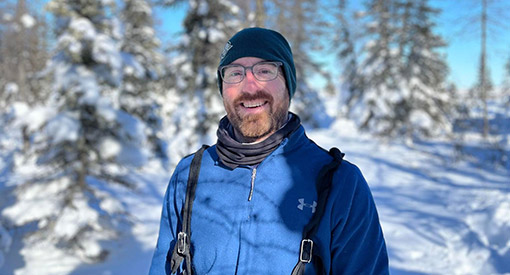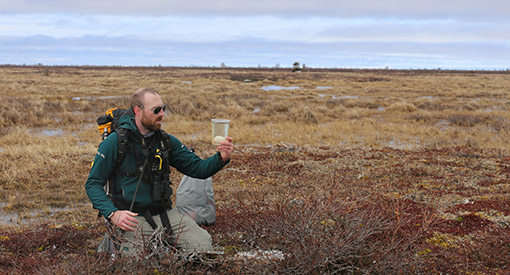Matt Webb
Wapusk National Park
Representing the Hudson/James Bay lowlands, one of the largest wetlands in North America, and reaching 11,475 square kilometres, Wapusk National Park is comprised of much more than the bog and fen that sprawl across its land.

Matt Webb is one of the few who has spent countless hours in Wapusk National Park, conducting fieldwork and collecting important ecological data since joining Parks Canada in 2016 as a research technician, and later as the park ecologist and research coordinator.
Although Matt had previously visited Wapusk with a prior employer, it was on his first trip flying over the park with Parks Canada that he gained a full appreciation for the vast transitionary landscape.
It was a beautiful summer day in July when Matt and his team flew to the southwest corner of the park to begin sampling lakes.
“It was the first time I got to see the full park, and I remember just taking it all in and really gaining an appreciation for the landscape and the way that it’s developed over the years,” Matt said.
Gradual changes
Situated at the edge of the arctic between the Churchill and Nelson river estuaries, Wapusk is unlike any typical park. It protects a transitionary landscape, with boreal forest to the south, arctic tundra to the north, and 230 kilometres of coastline along its eastern border. The interior of the park is comprised of peat plateaus which are dominated by ice-wedge peat polygons, and covered in mosses, lichens and small shrubs. The entire region is underlain by continuous and discontinuous permafrost, and impermeable silt-clay soils impede water infiltration creating thousands of thermokarst lakes that litter the landscape.
It is a sprawling landscape where gradual change continues to shape the land. This can be seen in the beach ridges, which were once at the bays edge, but now act as wildlife highways and can be found up to 10 km inland. A glacier once depressed the region and as it receded, the land began a rebounding process known as isostatic rebound. This process occurs rapidly at first, but slows over time and now amounts to a one-metre rise per century, moving the beach ridges further from the coast.
“Processes happen slowly here, from the air you can see where ponds once were, but have now filled with vegetation, and where oxbow lakes have formed by the changing river paths. You can see how the ecosystem itself has changed and continues to change,” Matt said.
Permafrost wells
As changes occur above ground in Wapusk, it’s what lies underneath the earth that is vital to the state of the park. Matt and his team care for the park’s permafrost monitoring wells, which provides important information about the permafrost that rests below.
Between 2007 and 2008, the wells were installed to look at the changes in permafrost from the coastline along transects inland. Transects are straight lines that cut through landscapes to help measure and record data, making them important tools for fieldwork observations. The permafrost wells help answer questions about where and why gaps are forming underneath the ground, and allow researchers to monitoring and compare air and ground temperatures.

“It’s all valuable information to assess how the environment is changing, because this entire landscape is supported by the permafrost. If it melts away, then it’s going to have considerable changes and impacts,” Matt explained.
In some areas, they have already begun to see slumping along the banks of some larger ponds, creating worry among researchers.
“The ecological importance of a peatlands of this size is that it is a huge carbon sink. It stores a lot of the greenhouse gases that we don’t want to be to released in to the atmosphere,” Matt said.
Once permafrost initially begins to thaw, the degradation process continues rapidly, making it virtually impossible to stop.
“There’s not a whole lot we can do other than try to slow or reverse the impacts of climate change, and that’s unfortunately a global issue,” Matt said.
To help address monitoring questions, Matt’s department has worked with external research partners. Most recently, they have been working with a group called ISAMR – International Student-Led Arctic Monitoring and Research. As part of the program, local and international high school students annually join Parks Canada at the well sites to collect active layer and vegetation plot data.
Fond memories
Throughout their busy work in Wapusk, Matt and his team make sure to take a moment to relax and take in their surroundings. Without access to internet or cell service in the park, there’s a calmness to being there.
“We have our emergency communications devices, but it’s not like having your cell phone in your pocket. There’s this sense of relaxation when you’re out there, and you know there’s no risk of your phone going off,” Matt recalled.

A couple of instances that stand out for Matt were this past winter (2021 to 2022) when he and his team were conducting snowpack sampling, and this summer when they were in the park to installing new infrastructure. On both trips, they had the opportunity to explore the surrounding area.
“After finishing the snowpack work, we ventured up the Broad River and explored branches of the Broad we had never visited before. The snow was deep and soft, and there were wildlife tracks scattered across the river. At one point we came across a picturesque creek, where the snow was completely undisturbed except for the tracks of a mother bear guiding her cubs to the sea ice,” Matt said.
“In the summer, while we were installing our Motus towers, we heard a commotion. When we looked over, we saw a wolf trying to chase down a caribou. That same trip, we had an eagle land about 10 feet from our camp and watch us work, and we had to opportunity to explore some of the Owl and Broad river banks adjacent to camp,” he added.
Matt appreciates every opportunity he has to conduct research in Wapusk, noting that it’s relaxing for him while being vital work.
“My goal is to protect and preserve the park, but also gain knowledge of the ecosystem processes and species it supports. To also be able to share that with all Canadians and, more importantly, with the communities that are most closely impacted,” Matt continued.
“It’s very important for us to be able to connect people with the land. By being able to share what we learn, share the knowledge and in some cases, share the experiences, I hope that we’re able to share the park with others.”
- Date modified :